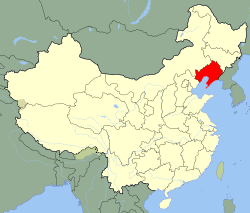Sujiatun Thrombosis Hospital

The Sujiatun Thrombosis Hospital, officially known as the Liaoning Provincial Thrombosis Treatment Center of Integrated Chinese and Western Medicine,[1][2] is a public hospital opened in December 1988 in the Sujiatun district of Shenyang, in northeast China. The hospital is a joint venture with a company associated with the Malaysian government,[3] and has gained several awards for research.[4] It was alleged in 2006 that the hospital was being used for live organ harvesting from 6,000 Falun Gong practitioners held prisoner in the basement.
Hospital
Sujiatun Thrombosis Hospital was opened in December 1988 as the Shenyang Research Institute of Thrombosis and Liaoning Province Thrombosis Treatment Center of Integrated Chinese and Western Medicine. It is a thrombosis treatment centre approved by the State Administration of Traditional Chinese Medicine, a class A Grade three hospital, a national Traditional Chinese Medicine (TCM) hospital, the general hospital for the Liaoning province, and a teaching hospital for the Liaoning University of TCM.[4]
The total hospital site is 21,087 square meters. The hospital has 27 clinical departments employing 460 people, and has 300 beds.[4]
The hospital has been granted several awards for research, including the Gold Prize at the 9th Inventions Exhibition and the Gold Cup Prize of China Excellent Invention Result. In November 2001, research at the hospital was awarded the Gold Prize at the 50th World Exhibition of Innovation, Research and New Technologies in Brussels. [4]
Allegation
In March 2006, the Falun Gong affiliated Epoch Times reported a claim that as many as 6,000 Falun Gong practitioners were being held for live organ harvesting.[1][2][5] The claim came against a background of international concern regarding China's transplantation programme and reports of persecution of the Falun Gong,[6] a spiritual movement banned in 1999 for "jeopardizing social stability".[7] Dissident human rights activist, Harry Wu, said that there was "no concrete or substantiated evidence".[8] U.S. officials investigated the hospital and found no evidence that it was being used for organ harvesting or detaining prisoners.[9][10]
References
- ↑ 1.0 1.1 Gertz, Bill (24 March 2006). "China harvesting inmates' organs, journalist says". Washington Times. Retrieved 21 October 2008.
- ↑ 2.0 2.1 Ji Da (17 March 2006). "New Witness Confirms Existence of Chinese Concentration Camp, Says Organs Removed from Live Victims". The Epoch Times. Retrieved 21 October 2008.
- ↑ "CLINICAL TRIAL PROPOSAL: A multi-center, open label trial to demonstrate the clinical effectiveness and safety of combined Traditional Chinese and Modern medicines in patients with recent stroke". Clinical Research Centre, Kuala Lumpur Hospital. 15 January 2005. Archived from the original on 30 June 2006.
- ↑ 4.0 4.1 4.2 4.3 General Situation of National Traditional Chinese Medicine Thrombus Treatment Center of P.C.R thrombusres-cn.net
- ↑ Nordlinger, Jay (30 March 2006). "A Place Called Sujiatun". National Review. Retrieved 21 October 2008.
- ↑ Thomas Lum (25 May 2006). "CRS Report for Congress: China and Falun Gong" (PDF). Congressional Research Service.
- ↑ Xinhua, China Bans Falun Gong, People's Daily, 22 July 1999
- ↑ Wu, Harry (8 June 2006). "Statement of Harry Wu about Sujiatun issue". Observechina.net. Archived from the original on 17 July 2011.
- ↑ "U.S. Finds No Evidence of Alleged Concentration Camp in China Repression of Falun Gong". Washington File. 16 April 2006. Retrieved 21 October 2008.
- ↑ Lum, Thomas (11 August 2006). "China and Falun Gong". Congressional Research Service. p. 10. Retrieved 21 October 2008.